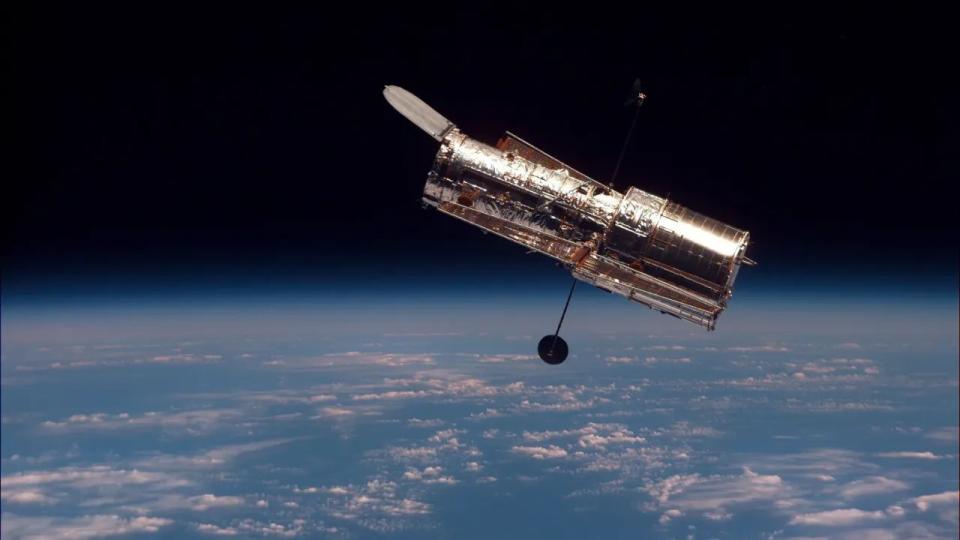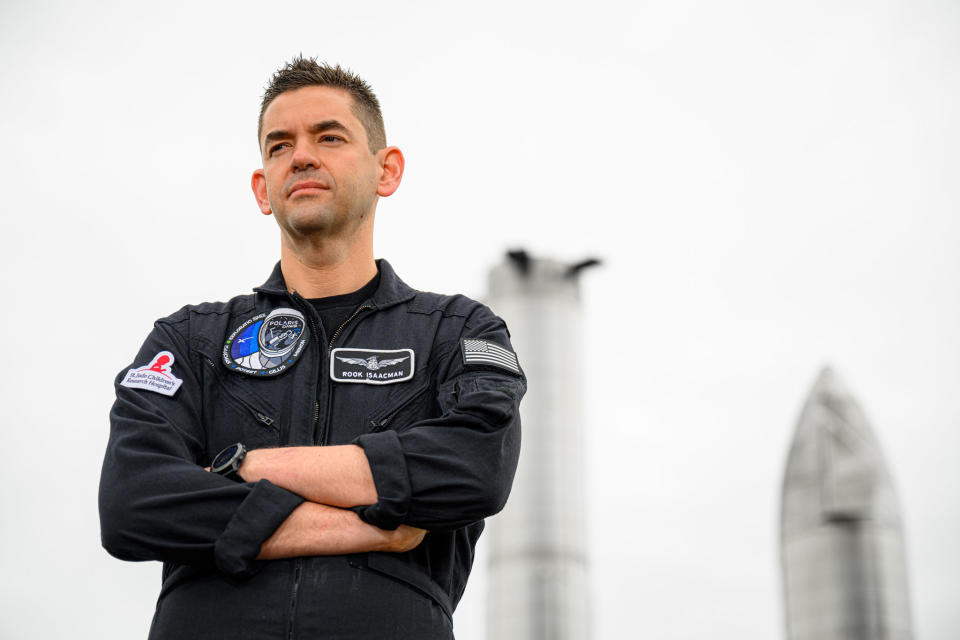NASA’s iconic Hubble Observatory still has years to live, and there are ideas in the works to perhaps keep it running even longer — but those proposals could face an uphill battle.
The Hubble Space Telescope, launched in 1990, has been serviced by astronauts five times and remains in good health. But the telescope is aging and slowly falling towards Earth due to the natural resistance of the atmosphere. That’s why billionaire entrepreneur and private astronaut Jared Isaacman helped propose a servicing mission to the telescope for the first time since 2009.
Isaacman – the commander of the private 2021 Inspiration4 mission, which he also financially supported – is also the financier and astronaut of the Polaris program. Polaris is a three-mission private astronaut series that flies SpaceX hardware and plans to conduct the first-ever commercial spacewalk this year, with Polaris Dawn.
The Polaris program’s Hubble proposal was first made public in 2022, and NASA asked other companies to also submit ideas in a request for information (ROI) that closed in early 2023. There are no official updates on the ROI yet, but the case recently appeared in the news again with a report from National Public Radio. The broadcaster obtained internal NASA emails through a Freedom of Information Act request, showing a range of reactions, including concerns from some people about the risk to Hubble.
Related: NASA wants ideas to launch the Hubble Space Telescope into a higher orbit using private spacecraft
Hubble’s last servicing mission in 2009 was a difficult decision for NASA. The agency, operating in the aftermath of the 2003 Columbia Space Shuttle disaster that killed seven astronauts, initially canceled the planned servicing mission. Their concern was that the Atlantis space shuttle could not reach the International Space Station for assistance, if needed, because of Hubble’s orbit, far away from the orbital complex.
However, after the scientific community expressed its concerns, NASA resumed the mission with backup: another space shuttle, Endeavor, was put on the launch pad, ready to assist Atlantis if necessary. However, the carefully choreographed maintenance mission did not require a backup; it met key maintenance objectives for Hubble, and the astronauts returned home without incident.

Hubble continues to make observations, after decades of groundbreaking work in areas ranging from the expansion of the universe to investigating changes in planetary weather.
However, Hubble can’t continue this way forever: instruments and systems are aging, the telescope periodically experiences “safe modes” (most recently for about a week in April), and the drag of Earth’s atmosphere is slowly pulling it out of orbit. soil. approximately 320 miles (515 kilometers). (For comparison, the ISS is about 250 miles, or 400 km away.)
In addition, the space shuttle and its spacious cargo area are no longer available for repairs; that program ended in 2011 and required new technical solutions if anyone wanted to operate Hubble again. The timeline for such a mission would likely require years of planning, and since there has been no update on the proposals since 2023, the status of any new service efforts is unclear.
Hubble’s instruments and primary subsystems (such as solar panels and batteries) “will continue to operate into the second half of the 2020s and possibly into the 2030s,” assuming no unforeseen events occur, NASA officials have stated. However, Isaacman and the Polaris program hope to keep Hubble going for much longer – perhaps another twenty years – through a servicing mission.
Related: A private plan to save the Hubble telescope could also target space junk
The lengthy NPR report highlighted several views from interviewees and emails, ranging from praise for Polaris’ innovation and for the quality of its engineering work, to concerns about a few things. One of those concerns was that Polaris has not yet completed a spacewalk, namely the SpaceX EVA [extravehicular activity] suits have not yet been tested in space, that reaching Hubble is difficult even for NASA astronauts and that any spacewalk near the telescope carries a risk of damaging it.
(Isaacman was unavailable for an NPR interview due to his Polaris training schedule, SpaceX did not respond to NPR’s requests, and NASA sent brief statements to the broadcaster publicly promising detailed follow-ups in the near future. The European Space Agency, also a financier for the telescope, was not interviewed.)
The joint NASA-Polaris Hubble feasibility study hasn’t been released yet, but “hopefully that will materialize,” Isaacman wrote on X (formerly Twitter), saying a technical analysis was conducted over six months and a formal recommendation was made.
Isaacman added that he fears that public discourse since then has, in his view, unfairly fallen into camps including “new space versus old space, or people who love SpaceX versus hate SpaceX, incompetent tourists versus real astronauts.”
Related: Photos: Servicing missions of NASA’s Hubble Space Telescope


“It really should have just been about the mission, because if a mission had been planned, there would have been resources from all the organizations participating in the study to ensure success,” Isaacman emphasized.
“It’s not like anyone would embark on it, especially after a joint study was put together to generally determine how a successful mission could be achieved,” added Isaacman, whose resume includes more than 6,000 hours as a pilot of various aircraft, including time spent on contingencies. or conducting flight formations.
Isaacman paid tribute to the previous maintenance missions managed by NASA. Each round required several spacewalks, along with replacing major instruments and using the space shuttle’s Canadian robotic arm, called Canadarm. Planning for these missions would always take several years, including ample spacewalk exercises by the organization’s astronauts.
However, advances in electronics over the past 15 years mean that today you can pack a lot of capabilities into something the size of an iPhone, says Isaacman.


As for the risk for Hubble to have to service it again, Isaacman said that, apart from Hubble falling back to Earth, “many of the telescope systems have failed and most of the redundancy has been lost. This is why it still goes offline. .”
In a recent NASA statement, agency officials pointed to a single faulty gyroscope as the culprit behind the April 2024 safe mode incident, as well as another incident in November 2023. But there are two other gyroscopes that Hubble could use to orient oneself in space.
Although three of Hubble’s six gyros are no longer in use, and the best efficiency comes from using at least three for targeting, the observatory “could continue to make scientific observations using just one gyro if necessary,” the statement said . As for Hubble’s near-term health, “NASA expects Hubble to continue making groundbreaking discoveries,” the statement emphasized.
RELATED STORIES:
– How SpaceX’s private Polaris Dawn astronauts will undertake the first ever ‘fully civilian’ spacewalk
– SpaceX and NASA are considering launching Dragon for the Hubble Space Telescope
– NASA’s Hubble Telescope is back in action – but its TESS exoplanet hunter may now be in trouble
Hubble, Isaacman said, could only be boosted by Polaris until it reached a “certain altitude,” at which point it would (according to Isaacman) either fall uncontrollably back to Earth or — if a rescue attempt was desired at that point — would have fallen . be addressed by a robotic mission, which could come at taxpayer expense depending on what NASA wants to do.
“If a mission had been flown, and I had been happy to fund it, I believe it would have resulted in the development of capabilities beneficial to the future of commercial space and would have revitalized Hubble along the way.” , Isaacman added.
“I recognize that this is not my telescope to touch and that a lot of time has passed between the research and now. Government priorities are changing, budgets are becoming tight. Regardless of who funds the mission, there are contributions from many parties to ensure success, no matter what happens from here, I’m glad we all, including NASA, invested the time to see if Hubble deserved that effort.